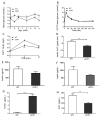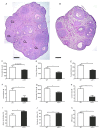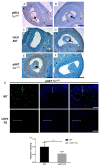Pseudo-Starvation Driven Energy Expenditure Negatively Affects Ovarian Follicle Development
- PMID: 33808081
- PMCID: PMC8036485
- DOI: 10.3390/ijms22073557
Pseudo-Starvation Driven Energy Expenditure Negatively Affects Ovarian Follicle Development
Abstract
In the present investigation, we examined whether a change in whole body energy fluxes could affect ovarian follicular development, employing mice ectopically expressing uncoupling protein 1 in skeletal muscle (UCP1-TG). Female UCP1-TG and wild-type (WT) mice were dissected at the age of 12 weeks. Energy intake and expenditure, activity, body weight and length, and body composition were measured. Plasma insulin, glucose, leptin, plasma fibroblast growth factor 21 (FGF21) and plasma insulin-like growth factor 1 (IGF1) levels were analyzed and ovarian follicle and corpus luteum numbers were counted. IGF1 signaling was analyzed by immunohistochemical staining for the activation of insulin receptor substrate 1/2 (IRS1/2) and AKT. UCP1-TG female mice had increased energy expenditure, reduced body size, maintained adiposity, and decreased IGF1 concentrations compared to their WT littermates, while preantral and antral follicle numbers were reduced by 40% and 60%, respectively. Corpora lutea were absent in 40% of the ovaries of UCP1-TG mice. Phospho-IRS1, phospho-AKT -Ser473 and -Thr308 immunostaining was present in the granulosa cells of antral follicles in WT ovaries, but faint to absent in the antral follicles of UCP1-TG mice. In conclusion, the reduction in circulating IGF1 levels due to the ectopic expression of UCP1 is associated with reduced immunostaining of the IRS1-PI3/AKT pathway, which may negatively affect ovarian follicle development and ovulation.
Keywords: AKT; IGF1; IRS1; UCP1; energy metabolism; ovarian follicular development.
Conflict of interest statement
The authors declare no conflict of interest.
Figures







Similar articles
-
G protein-coupled receptors (GPCRs) That Signal via Protein Kinase A (PKA) Cross-talk at Insulin Receptor Substrate 1 (IRS1) to Activate the phosphatidylinositol 3-kinase (PI3K)/AKT Pathway.J Biol Chem. 2016 Dec 30;291(53):27160-27169. doi: 10.1074/jbc.M116.763235. Epub 2016 Nov 17. J Biol Chem. 2016. PMID: 27856640 Free PMC article.
-
Skeletal muscle mitochondrial uncoupling drives endocrine cross-talk through the induction of FGF21 as a myokine.Am J Physiol Endocrinol Metab. 2014 Mar 1;306(5):E469-82. doi: 10.1152/ajpendo.00330.2013. Epub 2013 Dec 17. Am J Physiol Endocrinol Metab. 2014. PMID: 24347058
-
Activation of AMPKα2 is not crucial for mitochondrial uncoupling-induced metabolic effects but required to maintain skeletal muscle integrity.PLoS One. 2014 Apr 14;9(4):e94689. doi: 10.1371/journal.pone.0094689. eCollection 2014. PLoS One. 2014. PMID: 24732703 Free PMC article.
-
IGF1 induces up-regulation of steroidogenic and apoptotic regulatory genes via activation of phosphatidylinositol-dependent kinase/AKT in bovine granulosa cells.Reproduction. 2010 Jan;139(1):139-51. doi: 10.1530/REP-09-0050. Reproduction. 2010. PMID: 19819918
-
Exogenous insulin-like growth factor 1 accelerates growth and maturation of follicles in human cortical xenografts and increases ovarian output in mice.F S Sci. 2021 Aug;2(3):237-247. doi: 10.1016/j.xfss.2021.07.002. Epub 2021 Jul 20. F S Sci. 2021. PMID: 35560275 Free PMC article.
Cited by
-
Umbilical Cord Mesenchymal Stem Cells Ameliorate Premature Ovarian Insufficiency in Rats.Evid Based Complement Alternat Med. 2022 May 30;2022:9228456. doi: 10.1155/2022/9228456. eCollection 2022. Evid Based Complement Alternat Med. 2022. PMID: 35677383 Free PMC article.
-
Sow reproductive disorders: a key issue affecting the pig industry.Front Vet Sci. 2025 Mar 5;12:1535719. doi: 10.3389/fvets.2025.1535719. eCollection 2025. Front Vet Sci. 2025. PMID: 40110434 Free PMC article. Review.
-
Prolonged fasting induces significant germ cell loss in chickens after hatching.Poult Sci. 2023 Aug;102(8):102815. doi: 10.1016/j.psj.2023.102815. Epub 2023 May 29. Poult Sci. 2023. PMID: 37356301 Free PMC article.
References
MeSH terms
Substances
Grants and funding
LinkOut - more resources
Full Text Sources
Other Literature Sources
Research Materials
Miscellaneous

